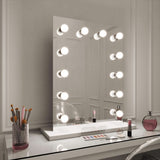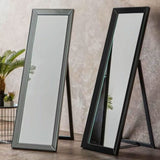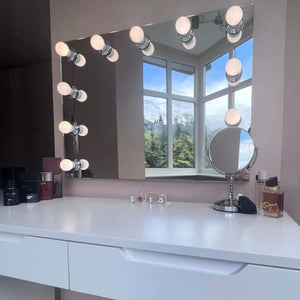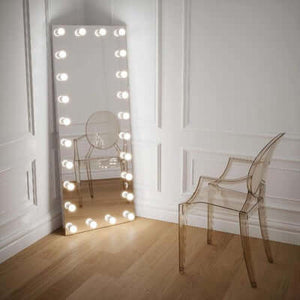A dressing table mirror is a vital addition to any beauty routine, but how do you decide on the right size?
The perfect mirror should not only reflect your image but also fit harmoniously into your space.
Hollywood mirrors, with their iconic lighting and sleek designs, are particularly popular for dressing tables.
This article will guide you through the necessary considerations, helping you select the perfect size for your needs.
Let’s start with the factors to consider when choosing a dressing table mirror.
Factors to Consider When Choosing Mirror Size
Choosing the right size depends on your specific needs and the dimensions of your room. A larger mirror with good lighting is essential if you primarily apply makeup.
Additionally, consider your height; a taller person may need a larger mirror to see their full reflection comfortably.
You should also pay attention to how you typically use the mirror and choose a size that suits your habits and preferences.
Here are the factors that should be considered:
1: Purpose:
Consider whether the mirror is primarily for makeup application, hair styling, or general grooming, as this will influence the size you need.
2: Room size:
Larger rooms can accommodate bigger mirrors, while smaller spaces may benefit from more compact designs to avoid a cramped feel.
3: Space availability:
Measure the dimensions of your dressing table and the surrounding area to ensure the mirror fits comfortably without overwhelming the space.
4: Height and angle:
Determine how high you typically sit and the angle at which you want to view your reflection. A taller mirror may be needed for full visibility.
5: Reflective surface:
Consider if you need a larger surface area for multi-tasking or a more focused view for detailed work.
6:Lighting:
Ensure the mirror size works well with your lighting setup, allowing for optimal visibility without shadows.
7: Style and design:
The mirror's size should complement your overall decor and the size of the furniture to maintain a balanced aesthetic.
Standard Sizes for Dressing Table Mirrors
There are several standard sizes when it comes to dressing table mirrors, however, these are widely known sizes:
-
Small mirrors (20-24 inches): Small mirrors are best for compact spaces or as accent pieces
-
Medium mirrors (24-36 inches): Ideal for average-sized dressing tables, offering a balance between functionality and space
-
Large mirrors (36 inches and above): Large mirrors are suitable for spacious areas. They serve as stunning focal points while providing a full view
Key Dimensions in Measuring Your Dressing Table
When measuring your dressing table for the perfect mirror, focus on the following key dimensions:
-
Height: Assess the height of the table from the floor to the top. This will help you find a mirror that allows for comfortable viewing while sitting.
-
Width: Measure the total width of your dressing table to determine how wide your mirror can be. Ideally, the mirror should be slightly narrower than the table for a balanced look.
-
Depth: Consider the depth of the table, especially if you're planning to place the mirror on it. Ensure that the mirror doesn’t extend too far back, which could affect usability.
-
Distance from Wall: If your table is positioned against a wall, measure the distance from the back of the table to the wall to ensure the mirror doesn’t hit or interfere with any fixtures.
-
Viewing height: Sit at the table and measure the height from your seated position to your eye level. This will help you select a mirror that offers the best angle for viewing.
-
Clearance space: Account for any items that might be on the table, ensuring the mirror’s size allows for adequate space for your grooming products and accessories.
How To Get The Right Proportions And Scale For Your Mirror
Proportion is a fundamental principle in interior design that impacts the overall harmony of a space.
When selecting a dressing table mirror, achieving the right proportion ensures that the mirror complements other elements in the room, creating a cohesive look.
A well-proportioned mirror enhances visual balance, making the space feel more inviting and well-thought-out. If the mirror is too large or too small compared to the table, it can disrupt the flow and make the area feel cluttered or disproportionate.
The general rule is that the mirror should be roughly two-thirds the width of the dressing table. This ratio helps maintain balance, ensuring the mirror is substantial enough to be functional while not overwhelming the table.
For instance, if your dressing table measures 48 inches wide, a mirror around 32 inches wide would be ideal. This proportion allows for effective reflection and usage without compromising the elegance of the setup. Adhering to this rule provides a solid foundation for creating a stylish and functional dressing area.
Tips for Mirror Style and Decor
To ensure your mirror complements your existing decor, consider color and style coordination.
Choose a frame that matches your dressing table and the overall theme of your room.
For instance, if your room features a chic, modern design, opt for a sleek Hollywood mirror. Conversely, if your decor is more classic, an ornate framed mirror may be a better fit.
1. Match the frame to your decor
Choose a mirror frame that complements your dressing table and room style. For a modern look, opt for sleek, minimalist frames. For a vintage or rustic vibe, consider ornate or distressed finishes.
2. Consider color schemes
Select a mirror color that harmonizes with the overall color palette of the room. Neutral tones work well in versatile settings, while bold colors can serve as statement pieces.
3. Layer with accessories
Enhance your dressing table's aesthetics by layering the mirror with decorative items. Use vases, candles, or framed photos to create visual interest and personality around the mirror.
4. Use mirrors to create illusions
Strategically place mirrors to reflect light or views, making the space feel larger and brighter. A well-placed mirror can open up a small room and add depth to your decor.
5. Incorporate lighting
Choose mirrors with integrated lighting or place them near light sources. Good lighting not only enhances functionality but also highlights the mirror as a decorative element.
Common Mistakes To Avoid When Selecting A Mirror
1. Ignoring size proportions
One of the most common mistakes is choosing a mirror that is either too large or too small for the dressing table. Always ensure that the mirror’s size is proportionate to the table, ideally about two-thirds the width of the table for balance.
2. Overlooking functionality
Selecting a mirror solely based on aesthetics can lead to practical issues. Consider how you’ll use the mirror if it’s primarily for makeup application, ensure it’s large enough and at the right height for clear visibility.
3. Neglecting the style of the room
Choosing a mirror that doesn’t align with the existing decor can create visual discord. Always match the mirror’s style—whether modern, rustic, or vintage—to your room’s overall theme.
4. Failing to consider lighting
Positioning a mirror without considering its relation to natural or artificial light sources can diminish its effectiveness. A well-placed mirror should reflect light to enhance brightness in the space.
5. Skipping the material quality
Opting for a low-quality mirror can affect both appearance and longevity. Always check the material and craftsmanship to ensure it meets your standards for durability and aesthetics.
6. Forgetting to test placement
Not visualizing how the mirror will look in its intended space can lead to regrets. Before making a purchase, sketch the layout or use painter's tape to mark the mirror's dimensions on the wall to see how it fits.
7. Disregarding maintenance needs
Some mirror finishes require more upkeep than others. Consider how much maintenance you’re willing to commit to when selecting materials like gold or intricate frames that may collect dust.
8. Choosing the wrong shape
The shape of the mirror should complement both the dressing table and the overall room. For example, a round mirror can soften angular furniture, while a rectangular mirror can create a more streamlined look.
By avoiding these common pitfalls, you can ensure that your mirror choice enhances both the functionality and beauty of your dressing table and surrounding decor.
Conclusion
Remember, the ideal dressing table mirror is one that fits seamlessly into your lifestyle and enhances your self-care routine.
By carefully considering your space and style, you can find a mirror that not only serves its purpose but also becomes a focal point in your home.
Next step? Discover the best selection of dressing table mirrors at Hollywood Mirrors!
Liquid error (sections/article-template line 192): Invalid form type "1\n", must be one of ["product", "storefront_password", "contact", "customer_login", "create_customer", "recover_customer_password", "reset_customer_password", "guest_login", "currency", "activate_customer_password", "customer_address", "new_comment", "customer", "localization", "cart"]
 Alicia Hollywood Mirror 60cmx80cm
Alicia Hollywood Mirror 60cmx80cm Angelina Full Length Arch Hollywood Mirror 160 x 60cm
Angelina Full Length Arch Hollywood Mirror 160 x 60cm Angled Luna Mirror-Cheval Black
Angled Luna Mirror-Cheval Black Angled Luna Mirror-Cheval Gray
Angled Luna Mirror-Cheval Gray




































